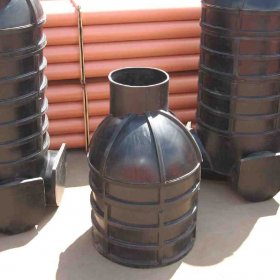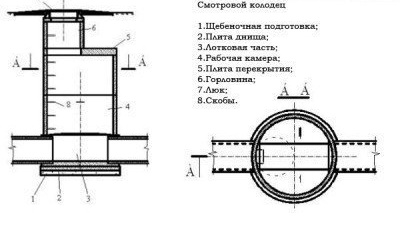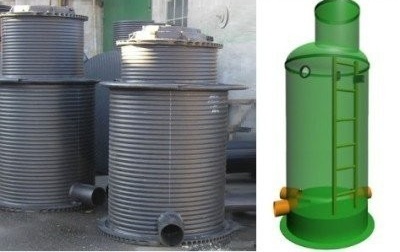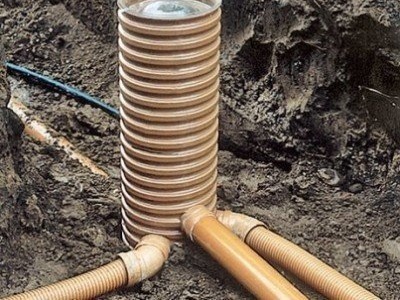Manhole for sewage or drainage - questions on the device and installation

Drainage and sewage systems, like any other engineering structures, cannot exist without periodic preventive maintenance and control over the functioning and general condition of the equipment. For these purposes, a viewing well is usually used, or rather, a competently equipped system of such structures. Not a single sewage or drainage pipeline can do without them, especially in areas where its slope, direction, diameter of pipes, etc. change.
Design and classification of inspection wells
All manholes have a similar design. They usually consist of several elements:
- Luke;
- neck;
- working chamber;
- tray;
- the basis.

Diagram of a device for a typical viewing well - the upper part with a cover should be easily accessible so that the liquid level can be monitored
The shape of the well can be either round or quadrangular. The base of the structure is most often made of reinforced concrete slabs laid on crushed stone. The design feature of the equipment is the tray into which the pipeline passes at the entrance to the well.
At the bottom, the tray follows the shape of the pipe. An element is made of concrete, the surface of the part is wiped. In some cases, ironing is also used. Shelves are mounted on both sides of the tray, on which workers are housed during operational activities.
The dimensions of the working chamber should be quite sufficient so that a person can go down inside and perform the necessary manipulations. On the wall of the chamber are steps or staples for descent. The traditional arrangement of the manhole suggests that its height is 1800 mm. The neck ends with a hatch that rises 70-200 mm above the ground. For its manufacture, cast iron or special polymeric materials can be used.

Swivel manhole. The hatch at such a well is intended not only to protect the structure from debris, but should also provide the necessary safety, making it impossible for a person to fall into the well and other accidents
All inspection wells, depending on their design features, can be divided into several groups:
- Control. Settled in the areas of connections of the yard and street network. They should be located just behind the red line of development.
- Rotary. They are installed where the direction of the pipeline changes. The tray of such structures should be in the form of a smooth curve and exactly repeat the shape of the turn.
- Overflow. Mounted in areas where the levels of the inlet and outlet pipes do not match.
- Flushing. They are equipped at launch sites, where, due to the low speed of the liquid, sediment may form, which will require flushing of the pipes.
- Linear Mounted on straight sections of the pipeline. The exact distance between the manholes is calculated based on the diameter of the pipes.
- Nodal Installed at the junction of several branches of the pipeline. Typically, a node connects three inlet and outlet pipes.
Selection of material from which the construction will be made
Even at the design stage, it is necessary to determine what material the well shaft will be made of. Most often in practice, two options are used:
- Plastic containers. Favorably characterized by low weight and, accordingly, the absence of problems with installation. In addition, corrugated shafts make it possible to change linear dimensions, which is especially true in areas with large seasonal temperature differences. Since the container does not deform during thawing and freezing of the soil. Also, plastic structures are characterized by durability and tightness.
- Reinforced concrete rings. The most durable and durable option. However, the installation of the device is associated with serious difficulties associated with the large weight of the structure.
Features of installation of a well for drainage
At each site where there is a need for drainage of groundwater, a drainage system is established. Its integral part is the viewing drainage well. Its installation is not a whim at all. As experience shows, the subsoil waters are not clean enough and eventually bring mud sediment to the bottom of the reservoirs.
If it is not removed, it can clog the drainage system and disable it. Therefore, the arrangement of inspection wells is simply necessary. They are usually located at a distance of 35 to 50 meters in a straight line and through one turn with bends in the pipeline, as well as in places where the level of drains drops.
Installation of finished plastic containers does not require much trouble, however, such a system is quite expensive. To save a little, you can purchase each item separately. To install you will need:
- plastic bottom;
- corrugated pipe;
- rubber seals.
Important: To equip a simple inspection well, a pipe with a diameter of 460 mm is usually chosen. It will be quite enough to flush the structure with water from a hose if necessary. If it is supposed to sink inside the well, the diameter of the pipe should not be less than 925 mm.
To install inspection wells for drainage, you must perform the following operations:
- Capacity preparation. We measure the required length of the prepared pipe from the corrugation. We cut it and make holes in the walls for perforated pipes. We install sealing cuffs.
- Arrangement of the bottom. We dig a ditch of the required depth, build a crushed-sand bottom in it. Pour the mortar with a solution of cement. After it dries, we lay the geotextile.
- Installation of construction. We lay the bottom. We install a pipe on it, carefully connect the elements and carefully coat the joints with bituminous mastic. We bring drainage pipes to the well and insert them into the prepared holes in the walls of the well. Joints are also sealed with bitumen mastic.
- Backfill of the well. The free space near the mine is covered with gravel. It is better to select the material for work in a small fraction, without sharp fragments that can damage the pipe.
- Lid installation.

A manhole made of plastic can be equipped with your own hand, it is much easier to do than a concrete version
It is quite possible to equip the inspection well of a sewer or drain yourself, especially if you install a ready-made plastic container. This design is quite simple to install and at the same time durable. If you choose a device made of concrete, you won’t be able to do without the help of professionals, but durable equipment will last a very long time, providing the necessary maintenance and the possibility of carrying out preventive maintenance for the pipeline.



